Synthesis of Dense MgB2 Superconductor via In Situ and Ex Situ Spark Plasma Sintering Method
Abstract
1. Introduction
2. Experimental Section
3. Results and Discussion
3.1. Ex Situ Synthesis
3.2. In Situ Synthesis
3.3. Microstructural Analysis
3.4. Flux Pinning Analysis
4. Conclusions
Author Contributions
Funding
Institutional Review Board Statement
Informed Consent Statement
Data Availability Statement
Conflicts of Interest
References
- Russell, V.; Hirst, R.; Kanda, F.A.; King, A.J. An X-ray study of the magnesium borides. Acta Cryst. 1953, 6, 870. [Google Scholar] [CrossRef]
- Nagamatsu, J.; Nakagawa, N.; Muranaka, T.; Zenitani, Y.; Akimitsu, J. Superconductivity at 39 K in magnesium diboride. Nature 2001, 410, 63. [Google Scholar] [CrossRef] [PubMed]
- Murakami., A.; Noudem, J.; Guesmi, Z.; Kudo, T.; Iwamoto, A. Mechanical properties of MgB2 bulk fabricated by spark plasma sintering. Phys. Procedia 2015, 65, 77–80. [Google Scholar] [CrossRef][Green Version]
- Murakami, A.; Iwamoto, A.; Noudem, J.G. Mechanical properties of bulk MgB2 superconductors processed by spark plasma sintering at various temperatures. IEEE Trans. Appl. Supercond. 2018, 28, 8400204. [Google Scholar] [CrossRef]
- Eisterer, M.; Zehetmayer, M.; Weber, H.W. Current Percolation and Anisotropy in polycrystalline MgB2. Phys. Rev. Lett. 2003, 90, 247002. [Google Scholar] [CrossRef]
- Miryala, M.; Arvapalli, S.S.; Sakai, N.; Murakami, M.; Mochizuki, H.; Naito, T.; Fujshiro, H.; Jirsa, M.; Murakami, A.; Noudem, J. Complex pulse magnetization process and mechanical properties of spark plasma sintered bulk MgB2. Mat. Sci. Eng. B 2021, 273, 115390. [Google Scholar] [CrossRef]
- Noudem, J.G.; Dupont, L.; Gozzelino, L.; Bernstein, P. Superconducting properties of MgB2 bulk shaped by spark plasma sintering. Mater. Today Proc. 2016, 3, 545. [Google Scholar] [CrossRef]
- Gajda, D.; Morawski, A.; Zaleski, A.J.; Kurnatowska, M.; Cetner, T.; Gajda, G.; Presz, A.; Rindfleisch, M.; Tomsic, M. The influence of HIP on the homogeneity, Jc, Birr, Tc and Fp in MgB2 wires. Supercond. Sci. Technol. 2014, 28, 015002. [Google Scholar] [CrossRef]
- Gajda, D.; Morawski, A.; Zaleski, A.J.; Häßler, W.; Nenkov, K.; Rindfleisch, M.A.; Żuchowska, E.; Gajda, G.; Czujko, T.; Cetner, T.; et al. The critical parameters in in-situ MgB2 wires and tapes with ex-situ MgB2 barrier after hot isostatic pressure, cold drawing, cold rolling and doping. J. Appl. Phys. 2015, 117, 173908. [Google Scholar] [CrossRef]
- Shim, S.H.; Shim, K.B.; Yoon, J.W. Superconducting characteristics of polycrystalline MgB2 ceramics fabricated by a spark plasma sintering technique. J. Am. Ceram. Soc. 2015, 88, 858. [Google Scholar] [CrossRef]
- Aldica, G.; Batalu, D.; Popa, S.; Ivan, I.; Nita, P.; Sakka, Y.; Vasylkiv, O.; Miu, L.; Pasuk, I.; Badica, P. Spark plasma sintering of MgB2 in the two-temperature route. Phys. C Supercond. 2012, 477, 43. [Google Scholar] [CrossRef]
- Larbalestier, D.; Gurevich, A.; Feldmann, D.M.; Polyanskii, A. High-Tc superconducting materials for electric power applications. Nature 2001, 410, 368. [Google Scholar] [CrossRef]
- Braccini, V.; Nardelli, D.; Penco, R.; Grasso, G. Development of ex-situ processed MgB2 wires and their applications to magnets. Phys. C Supercond. 2007, 456, 209. [Google Scholar] [CrossRef]
- Glowacki, B.A.; Majoros, M.; Vickers, M.; Evetts, J.E.; Shi, Y.; McDougall, I. Superconductivity of powder-in-tube MgB2 wires. Supercond. Sci. Technol. 2001, 14, 193. [Google Scholar] [CrossRef]
- Yi, J.H.; Kim, K.T.; Jun, B.-H.; Joo, J.; Shon, J.M. Pore formation in in-situ processed MgB2 superconductors. Phys. C Supercond. 2009, 469, 1192. [Google Scholar] [CrossRef]
- Jo, W.; Huh, J.-U.; Ohnishi, T.; Marshall, A.F.; Beasley, M.R.; Hammond, R.H. In-situ growth of superconducting MgB2 thin films with preferential orientation by molecular-beam epitaxy. Appl. Phys. Lett. 2002, 80, 3563. [Google Scholar] [CrossRef]
- Zeng, X.H.; Sukiasyan, A.; Xi, X.X.; Hu, Y.F.; Wertz, E.; Li, Q. Superconducting properties of nanocrystalline MgB2 thin films made by an in situ annealing process. Appl. Phys. Lett. 2001, 79, 1840. [Google Scholar] [CrossRef]
- Liu, Y.; Cheng, F.; Qiu, W.; Ma, Z.; Hossain, S.; Dou, S.X. High performance MgB2 superconducting wires fabricated by improved internal Mg diffusion process at a low temperature. J. Mat. Chem. C 2016, 4, 9469–9475. [Google Scholar] [CrossRef]
- Giunchi, G.; Ceresara, S.; Ripamonti, G.; Di Zenobi, A.; Rossi, S.; Chiarelli, S.; Spadoni, M.; Wesche, R.; Bruzzone, P.L. High performance new MgB2 superconducting hollow wires. Supercond. Sci. Technol. 2003, 16, 285. [Google Scholar] [CrossRef]
- Fan, Z.Y.; Hinks, D.; Newman, N.; Rowell, J. Experimental study of MgB2 decomposition. Appl. Phys. Lett. 2001, 79, 87. [Google Scholar] [CrossRef]
- Schmitt, R.; Glaser, J.; Wenzel, T.; Nickel, K.; Meyer, H.-J. A reactivity study in the Mg-B system reaching for an improved synthesis of pure MgB2. Phys. C Supercond. 2006, 436, 38. [Google Scholar] [CrossRef]
- Brutti, S.; Balducci, G.; Gigli, G.; Ciccioli, A.; Manfrinetti, P.; Palenzona, A. Thermodynamic and kinetic aspects of decomposition of MgB2 in vacuum: Implications for optimization of synthesis conditions. J. Cryst. Growth 2006, 289, 578. [Google Scholar] [CrossRef]
- Guo, Y.; Zhang, W.; Yang, D.; Yao, R.-L. Decomposition and oxidation of magnesium diboride. J. Am. Ceram. Soc. 2012, 95, 754. [Google Scholar] [CrossRef]
- Kang, D.-K.; Kim, D.-W.; Kim, C.-J.; Ahn, I.-S. The Phase Analysis of Spark Plasma Sintered MgB2 After Ball Milling. J. Nanosci. Nanotechnol. 2010, 10, 142. [Google Scholar] [CrossRef] [PubMed]
- Dadiel, L.J.; Muralidhar, M.; Murakami, M. Flux pinning and superconducting properties of MgB2-diamond nanocomposites. J. Phys. Conf. Ser. 2017, 1054, 313. [Google Scholar]
- Dadiel, L.J.; Muralidhar, M.; Murakami, M. Improved superconducting performance of Ag-added nano-diamond doped MgB2. Proc. SPIE 2019, 11054, 110540I. [Google Scholar]
- Ojha, N.; Varma, G.D.; Singh, H.K.; Awana, V.P.S. Effect of rare-earth doping on the superconducting properties of MgB2. J. Appl. Phys. 2009, 105, 07E315. [Google Scholar] [CrossRef]
- Noudem, J.G.; Yiteng, X.; Pierre, B.; Richard, R.; Masaki, H.; Srikanth, S.A.; Miryala, M.; Masato, M. Improvement of critical current density of MgB2 bulk superconductor processed by Spark Plasma Sintering. J. Amer. Ceram. Soc. 2020, 103, 6169–6175. [Google Scholar] [CrossRef]
- Chen, D.; Goldfarb, R.B. Kim model for magnetization of type-II superconductors. J. Appl. Phys. 1989, 66, 2489–2500. [Google Scholar] [CrossRef]
- Balduccia, G.; Bruttia, S.; Cicciolia, A.; Giglia, G.; Manfrinettib, P.; Palenzonab, A.; Butmanc, M.F.; Kudinc, L. Thermodynamics of the intermediate phases in the Mg–B system. J. Phys. Chem. Solids 2005, 66, 292. [Google Scholar] [CrossRef]
- Prikhna, T.; Noudem, J.; Gawalek, W.; Mamalis, A.; Soldatov, A.; Savchuk, Y.; Moshchil, V.; Eisterer, M.; Weber, H.W.; Dub, S.; et al. Spark plasma synthesis and sintering of superconducting MgB2-based materials. Mat. Sci. Forum 2012, 721, 3. [Google Scholar] [CrossRef]
- Häßler, W.; Scheiter, J.; Hadrich, P.; Kauffmann-Weiß, S.; Holzapfel, B.; Oomen, M.; Nielch, K. Properties of ex-situ MgB2 samples prepared by uniaxial hot pressing and spark plasma sintering. Phys. C Supercond. Appl. 2018, 551, 48. [Google Scholar] [CrossRef]
- Yakıncı, M.E.; Balcı, Y.; Aksan, M.A.; Adiguzel, H.I.; Gencer, A. Degradation of Superconducting Properties in MgB2 by Formation of the MgB4 Phase. J. Supercond. 2002, 15, 607. [Google Scholar] [CrossRef]
- Dancer, C.E.J.; Prabhakaran, D.; Basoglu, M.; Yanmaz, E.; Yan, H.; Reece, M.; Todd, R.I.; Grovenor, C.R.M. Fabrication and properties of dense ex-situ magnesium diboride bulk material synthesize using spark plasma sintering. Supercond. Sci. Technol. 2009, 22, 095003. [Google Scholar] [CrossRef]
- Dew-Hughes, D. Flux pinning mechanisms in type-II superconductors. Philos. Mag. 1974, 30, 293. [Google Scholar] [CrossRef]
- Kramer, E.J. Scaling laws for flux pinning in hard superconductors. J. Appl. Phys. 1973, 44, 1360. [Google Scholar] [CrossRef]
- Koblischka, M.; Muralidhar, M. Pinning force scaling analysis of Fe-based high-Tc superconductors. Int. J. Mod. Phys. B 2016, 30, 1630017. [Google Scholar] [CrossRef]
- Kario, A.; Nast, R.; Häßler, W.; Rodig, C.; Mickel, C.; Goldacker, W.; Holzapfel, B.; Schultz, L. Critical current density enhancement in strongly reactive ex situ MgB2 bulk and tapes prepared by high energy milling. Supercond. Sci. Technol. 2011, 24, 075011. [Google Scholar] [CrossRef]
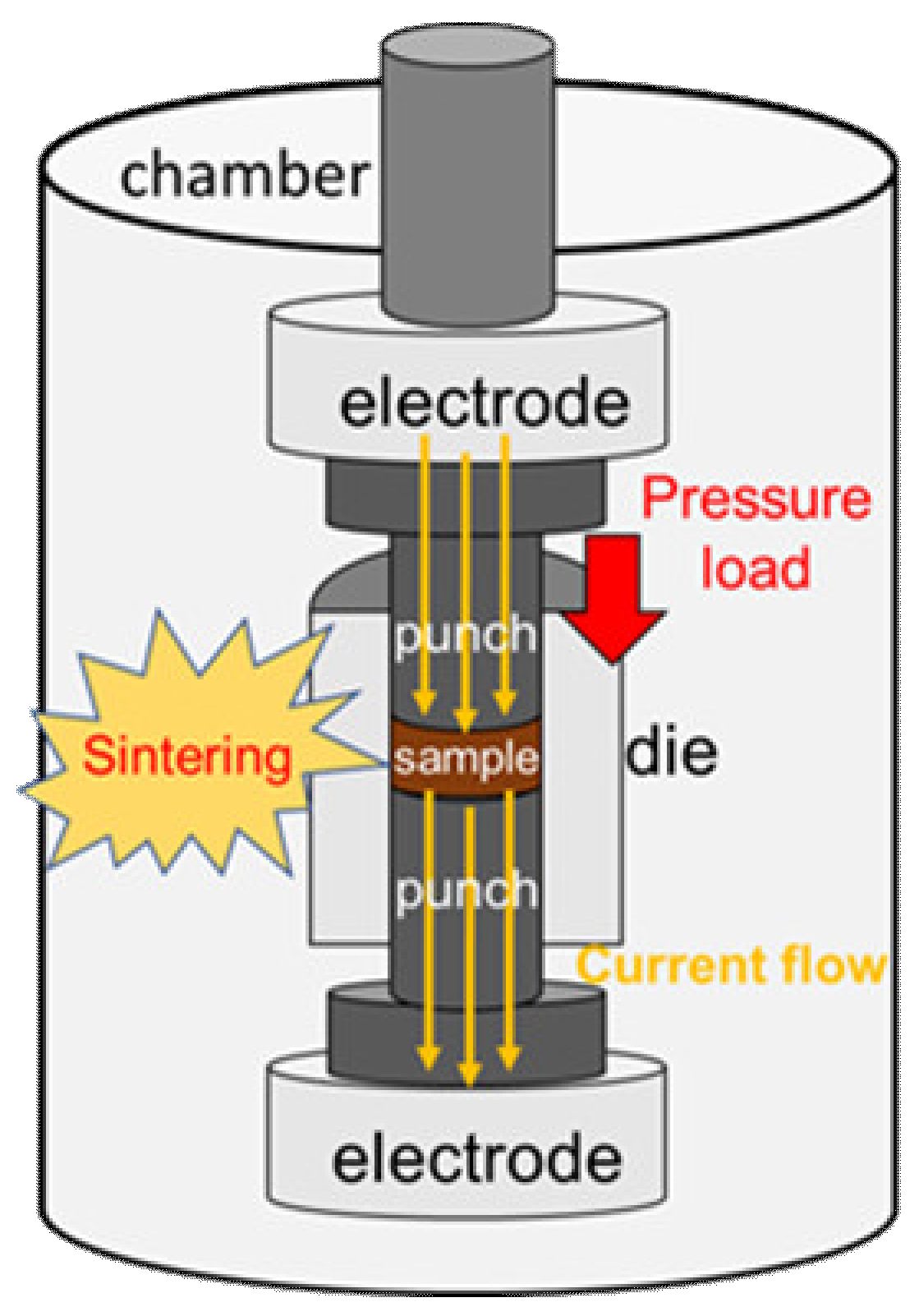
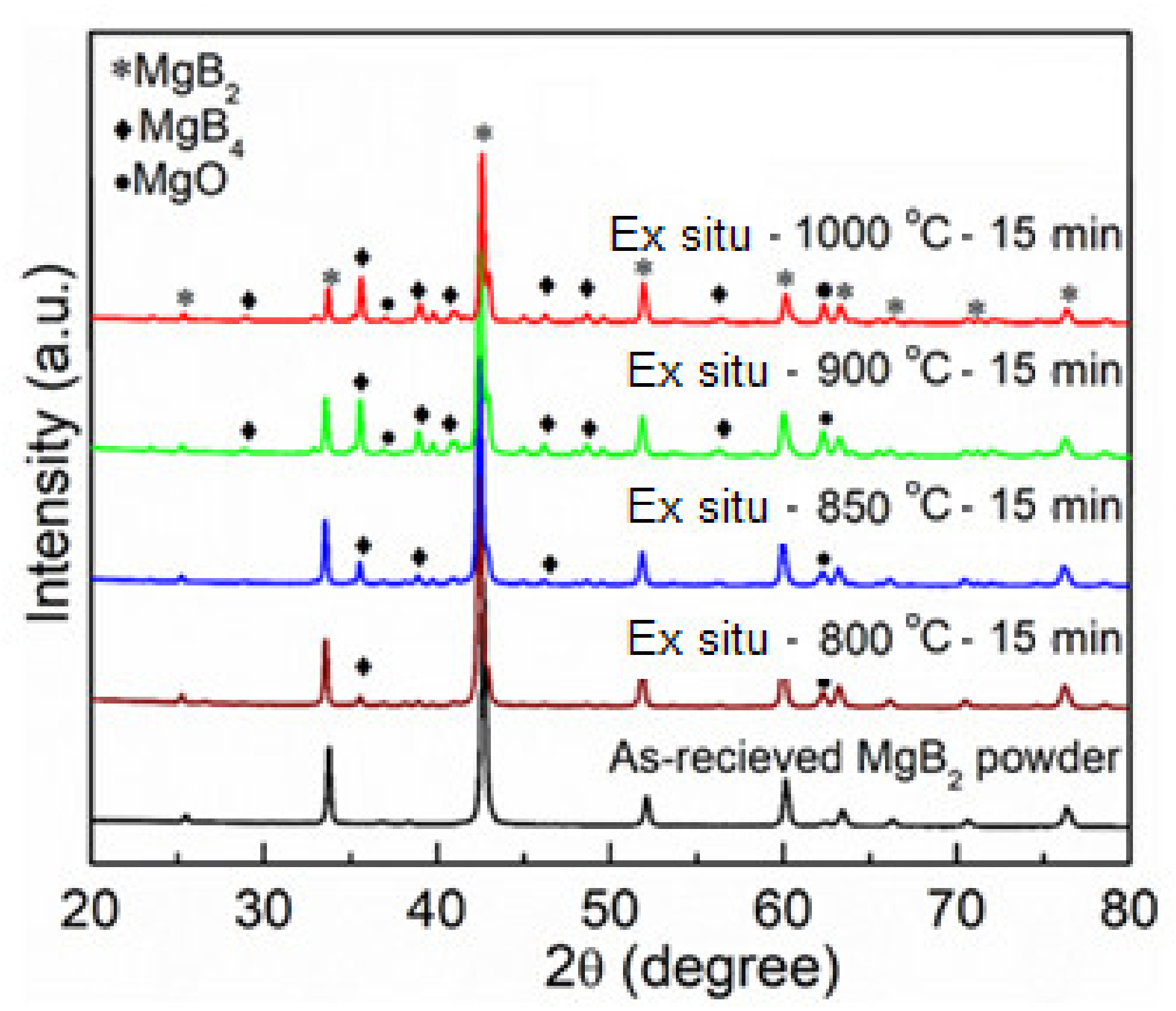
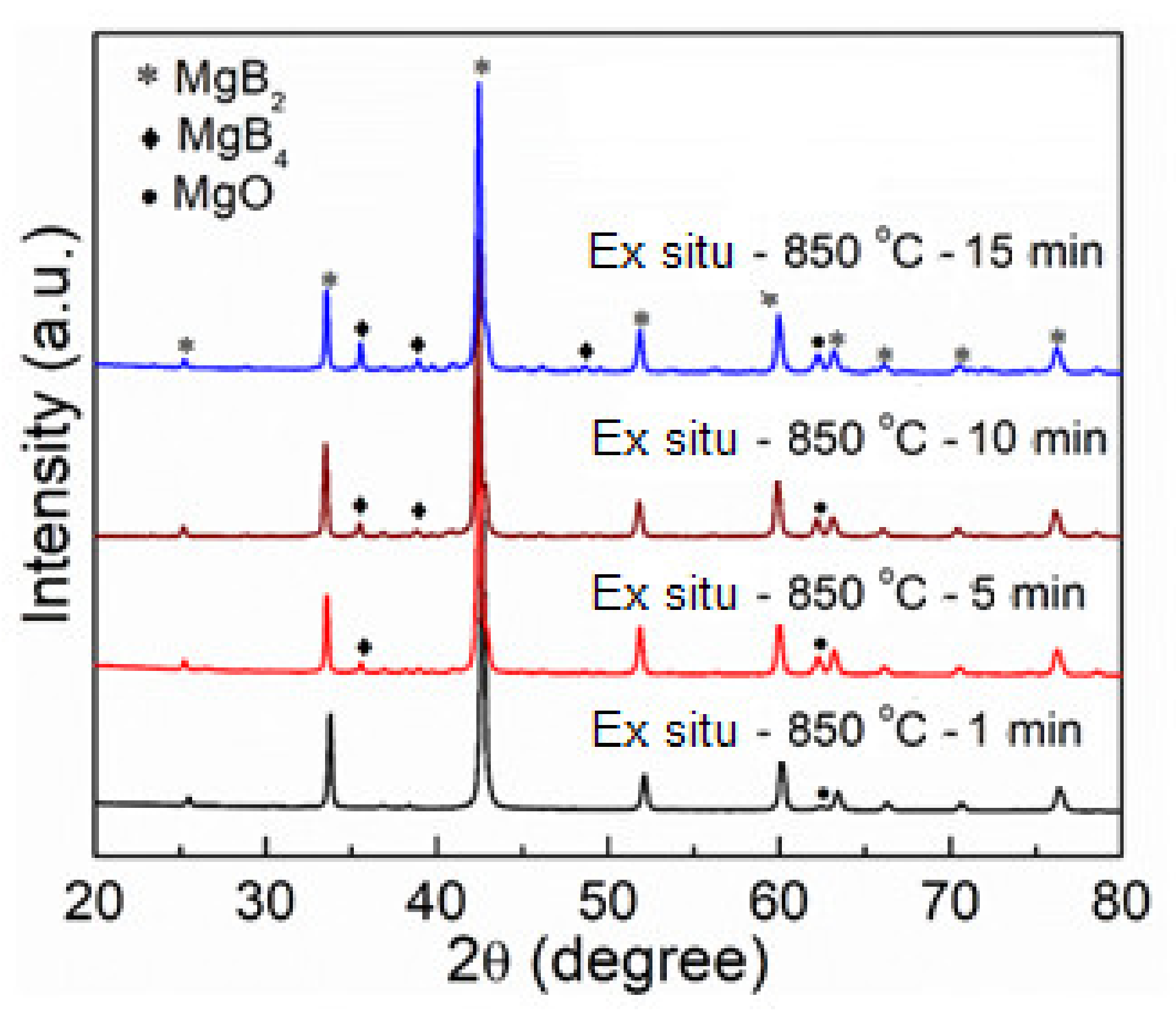
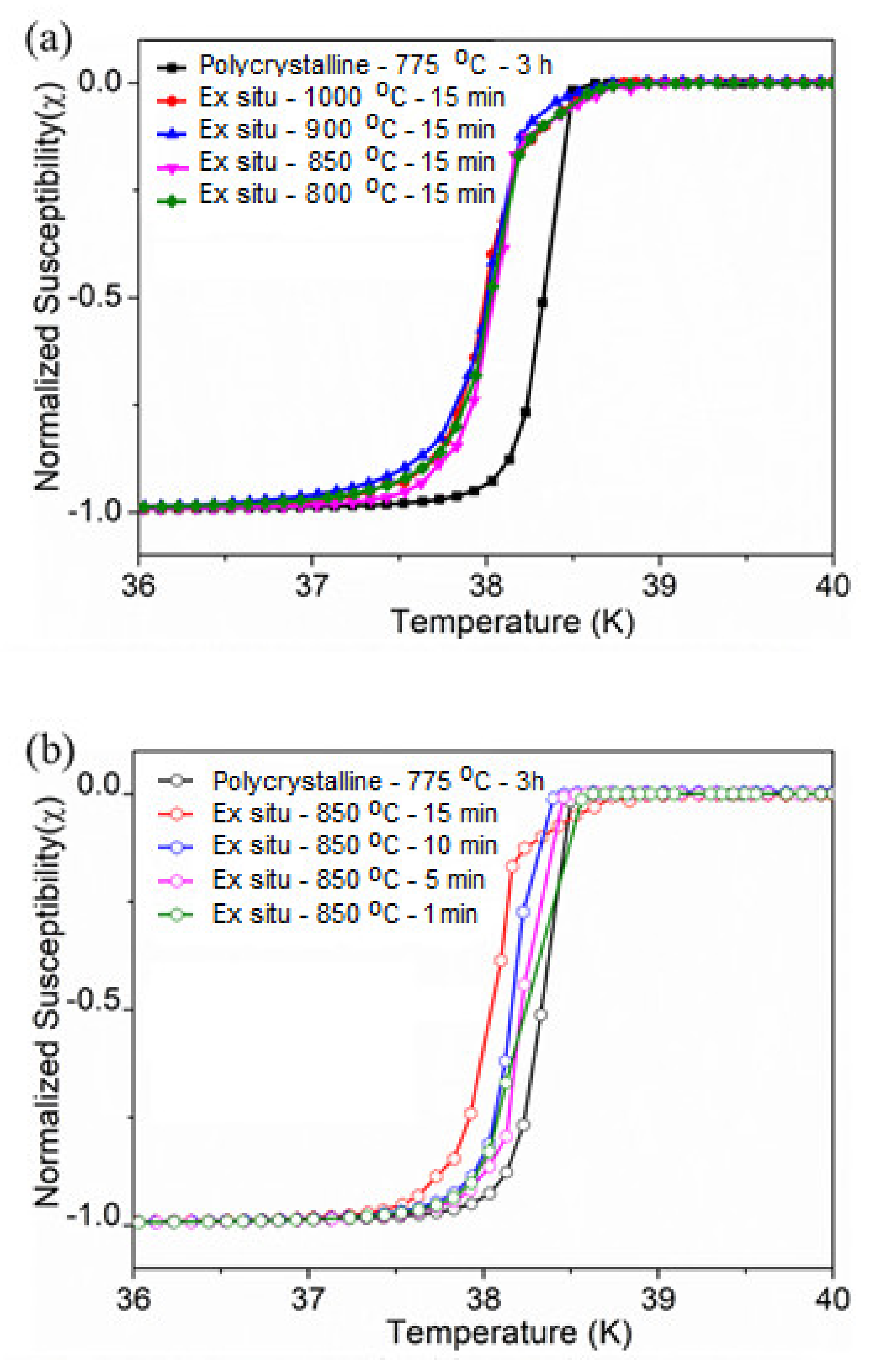

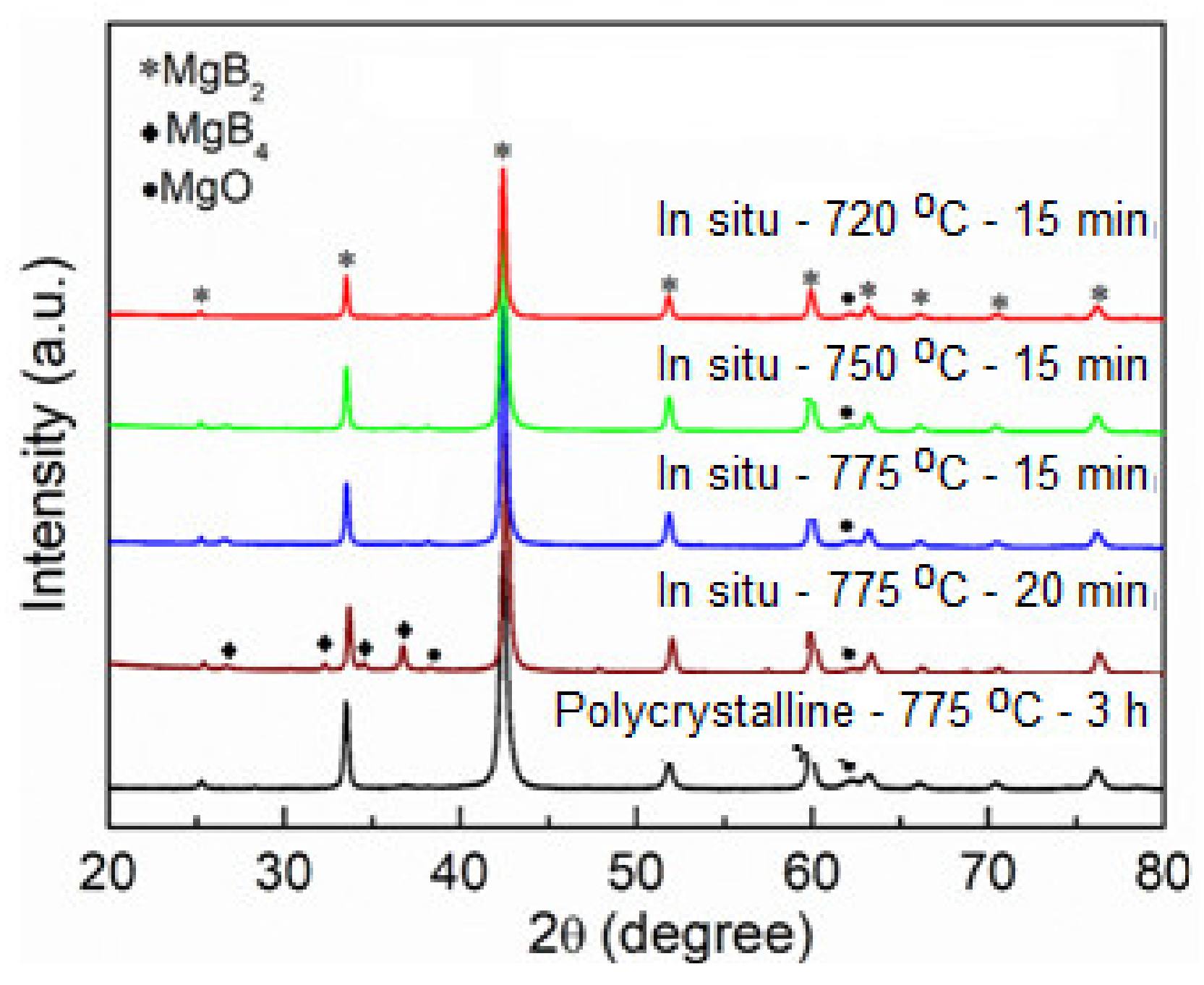
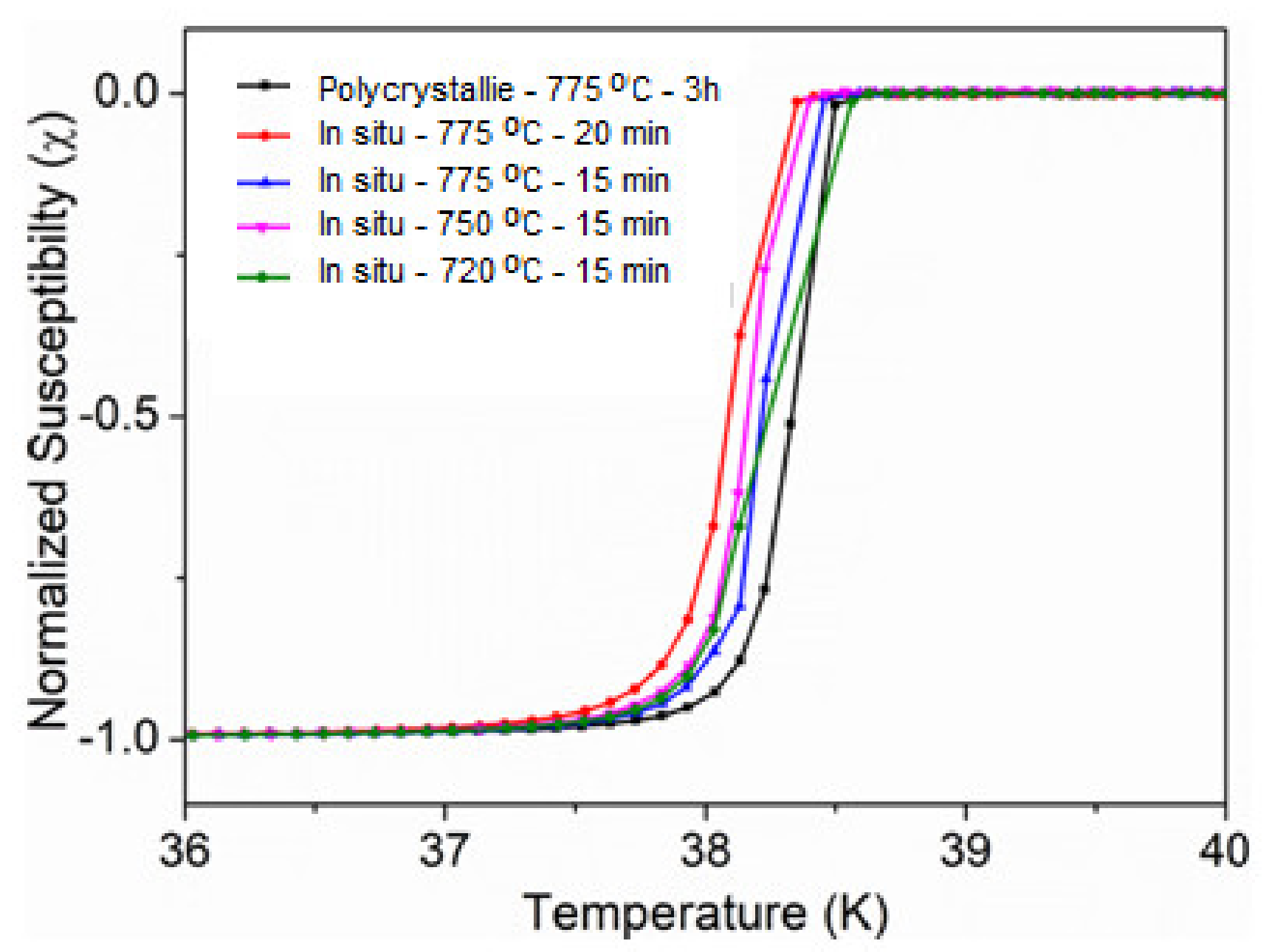
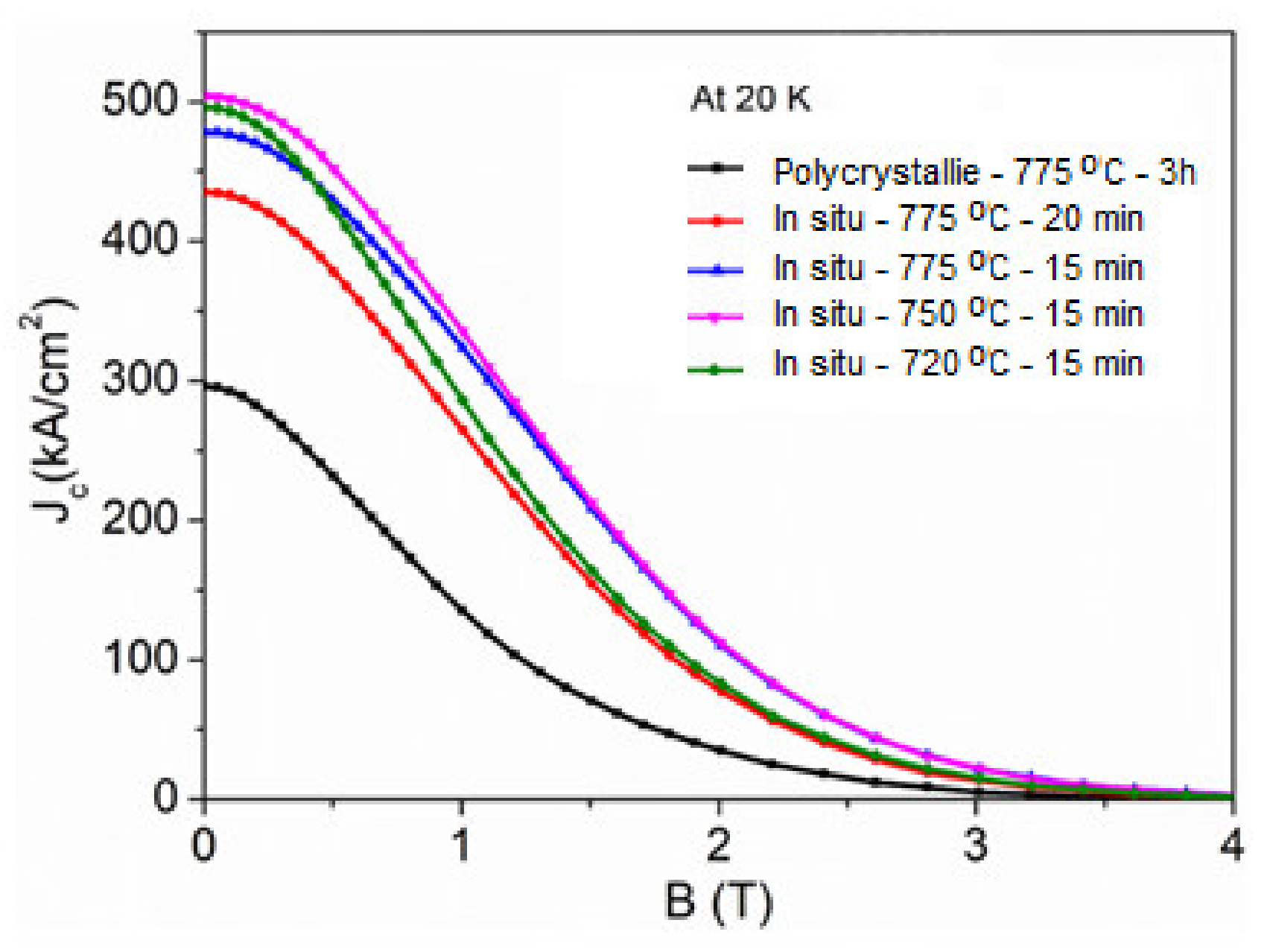
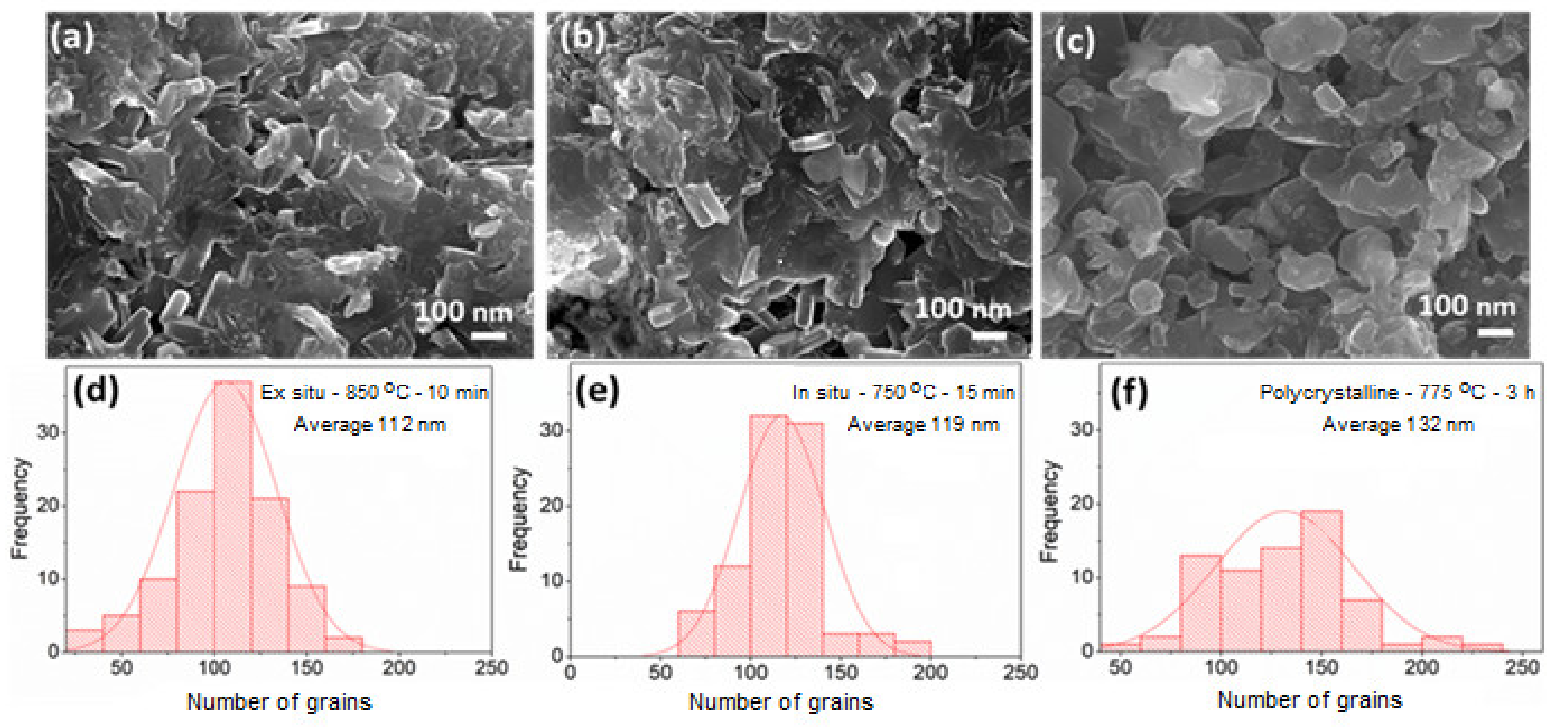
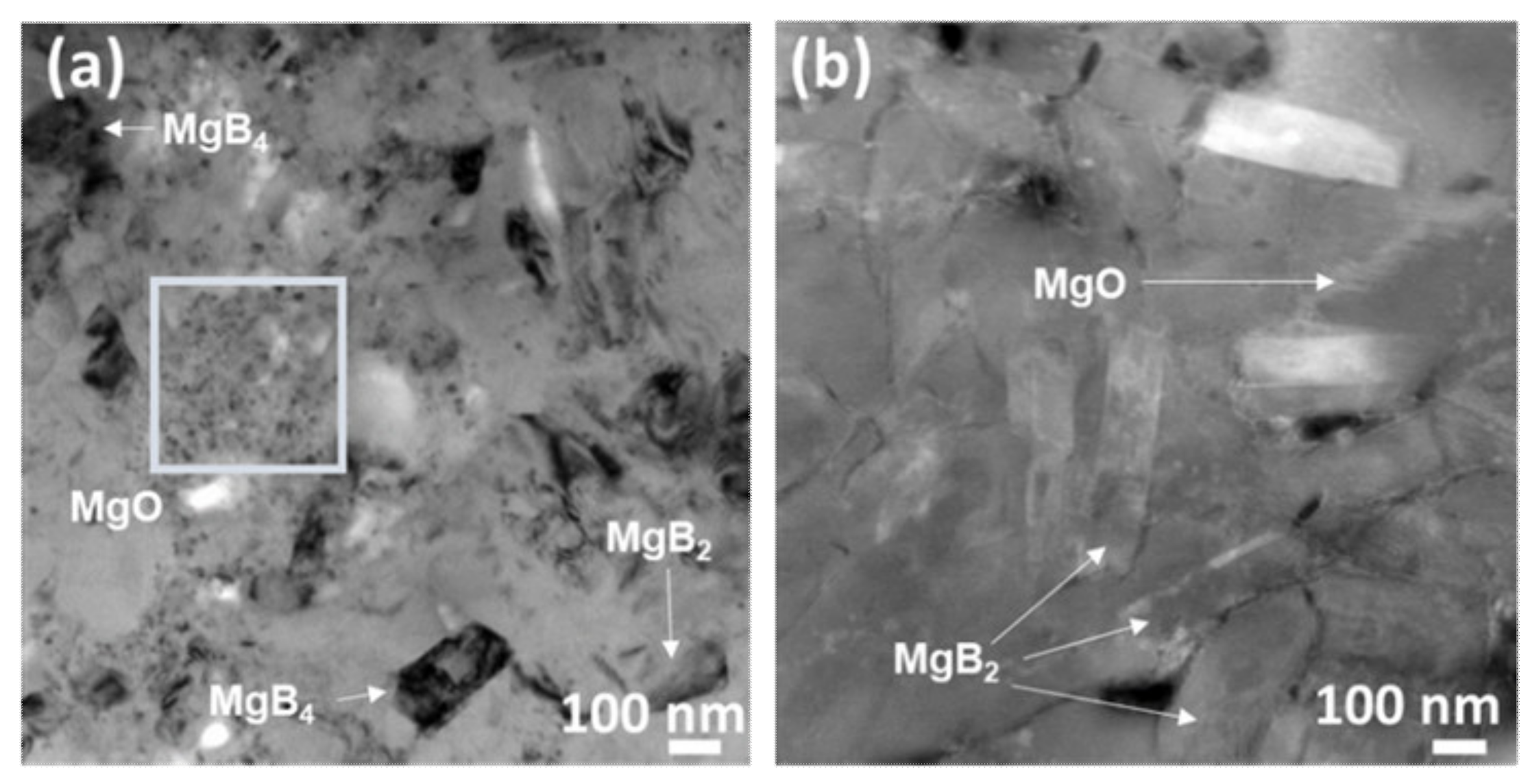
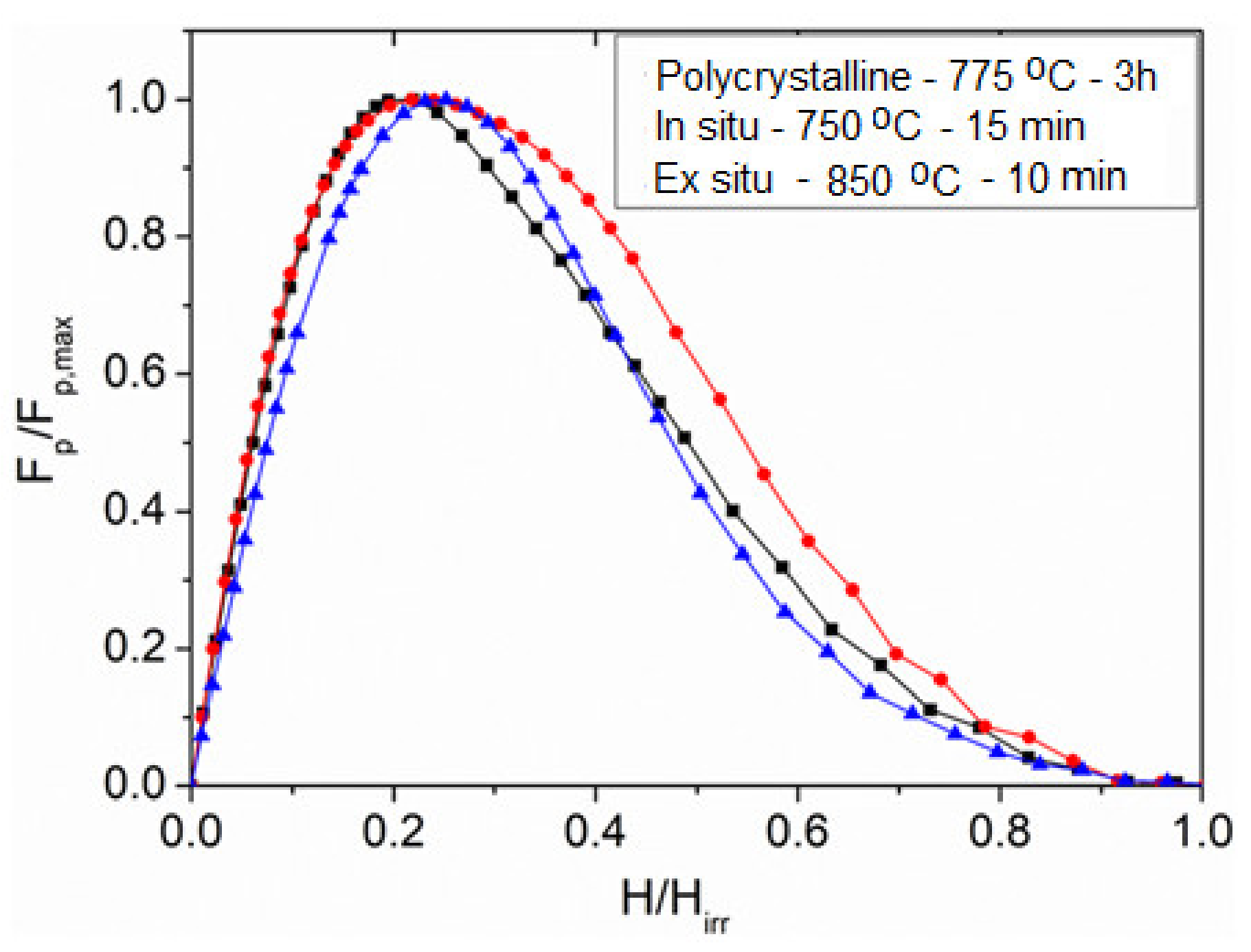
| Sample | Dwell Time (min) | Relative Density (%) | Superconducting Transition (K) Tc (onset) Tc (offset) ΔTc | Phase | ||
|---|---|---|---|---|---|---|
| Ex Situ | ||||||
| Ex situ_1000 °C | 15 | 99 | 38.3 | 37.7 | 0.6 | Decomposition present |
| Ex situ_900 °C | 15 | 99 | 38.2 | 37.7 | 0.5 | Decomposition present |
| Ex situ_850 °C | 15 | 97 | 38.2 | 37.7 | 0.4 | Decomposition reduced |
| Ex situ_800 °C | 15 | 92 | 38.1 | 37.7 | 0.4 | Little decomposition |
| Ex situ_850 °C | 10 | 97 | 38.3 | 38.0 | 0.3 | Improved phase/little MgO |
| Ex situ_850 °C | 5 | 89 | 38.1 | 37.8 | 0.3 | Improved phase/little MgO |
| Ex situ_850 °C | 1 | 86 | 38.5 | 37.9 | 0.6 | Little MgO |
| In Situ | ||||||
| In situ_775 °C | Tubular/3 h | 66 | 38.5 | 38.1 | 0.3 | Little MgO |
| In situ_775 °C | SPS/20 | 90 | 38.3 | 38.0 | 0.3 | MgO/MgB4 |
| In situ_775 °C | SPS/15 | 90 | 38.4 | 38.2 | 0.2 | Little MgO |
| In situ_750 °C | SPS/15 | 88 | 38.3 | 38.1 | 0.3 | Little MgO |
| In situ_720 °C | SPS/15 | 83 | 38.5 | 38.3 | 0.2 | Little MgO |
Publisher’s Note: MDPI stays neutral with regard to jurisdictional claims in published maps and institutional affiliations. |
© 2021 by the authors. Licensee MDPI, Basel, Switzerland. This article is an open access article distributed under the terms and conditions of the Creative Commons Attribution (CC BY) license (https://creativecommons.org/licenses/by/4.0/).
Share and Cite
Dadiel, J.L.; Naik, S.P.K.; Pęczkowski, P.; Sugiyama, J.; Ogino, H.; Sakai, N.; Kazuya, Y.; Warski, T.; Wojcik, A.; Oka, T.; et al. Synthesis of Dense MgB2 Superconductor via In Situ and Ex Situ Spark Plasma Sintering Method. Materials 2021, 14, 7395. https://doi.org/10.3390/ma14237395
Dadiel JL, Naik SPK, Pęczkowski P, Sugiyama J, Ogino H, Sakai N, Kazuya Y, Warski T, Wojcik A, Oka T, et al. Synthesis of Dense MgB2 Superconductor via In Situ and Ex Situ Spark Plasma Sintering Method. Materials. 2021; 14(23):7395. https://doi.org/10.3390/ma14237395
Chicago/Turabian StyleDadiel, Joseph Longji, Sugali Pavan Kumar Naik, Paweł Pęczkowski, Jun Sugiyama, Hiraku Ogino, Naomichi Sakai, Yokoyama Kazuya, Tymon Warski, Anna Wojcik, Tetsuo Oka, and et al. 2021. "Synthesis of Dense MgB2 Superconductor via In Situ and Ex Situ Spark Plasma Sintering Method" Materials 14, no. 23: 7395. https://doi.org/10.3390/ma14237395
APA StyleDadiel, J. L., Naik, S. P. K., Pęczkowski, P., Sugiyama, J., Ogino, H., Sakai, N., Kazuya, Y., Warski, T., Wojcik, A., Oka, T., & Murakami, M. (2021). Synthesis of Dense MgB2 Superconductor via In Situ and Ex Situ Spark Plasma Sintering Method. Materials, 14(23), 7395. https://doi.org/10.3390/ma14237395








